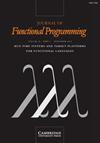可解释的动态编程
IF 1.1
3区 计算机科学
Q4 COMPUTER SCIENCE, SOFTWARE ENGINEERING
引用次数: 9
摘要
摘要在本文中,我们提出了一种解释动态规划(DP)算法产生的结果的方法。我们的方法基于保留在程序执行期间聚合的值的细粒度表示。从细粒度表示创建的解释可以回答为什么获得了一个结果而不是另一个结果的问题,因此可以提高对程序结果正确性的信心。我们对动态规划的关注源于这样一个事实,即动态规划提供了一种系统的方法来实现一大类优化算法,这些算法基于聚合值比较来产生决策。细粒度表示可以帮助解释这些决策。此外,动态编程可以使用半环形式化,这一事实支持创建用于动态编程的Haskell库,该库具有两个重要特性。首先,它允许程序员通过递归关系指定程序,从递归关系中自动派生出高效的实现。第二,动态程序可以被通用地公式化(作为类型类),这支持从只产生结果的程序到可以用细粒度表示运行并产生解释的程序的平稳过渡。最后,我们还演示了如何预测用户对程序结果的疑问,以及如何提前自动生成相应的解释。本文章由计算机程序翻译,如有差异,请以英文原文为准。
Explainable dynamic programming
Abstract In this paper, we present a method for explaining the results produced by dynamic programming (DP) algorithms. Our approach is based on retaining a granular representation of values that are aggregated during program execution. The explanations that are created from the granular representations can answer questions of why one result was obtained instead of another and therefore can increase the confidence in the correctness of program results. Our focus on dynamic programming is motivated by the fact that dynamic programming offers a systematic approach to implementing a large class of optimization algorithms which produce decisions based on aggregated value comparisons. It is those decisions that the granular representation can help explain. Moreover, the fact that dynamic programming can be formalized using semirings supports the creation of a Haskell library for dynamic programming that has two important features. First, it allows programmers to specify programs by recurrence relationships from which efficient implementations are derived automatically. Second, the dynamic programs can be formulated generically (as type classes), which supports the smooth transition from programs that only produce result to programs that can run with granular representation and also produce explanations. Finally, we also demonstrate how to anticipate user questions about program results and how to produce corresponding explanations automatically in advance.
求助全文
通过发布文献求助,成功后即可免费获取论文全文。
去求助
来源期刊

Journal of Functional Programming
工程技术-计算机:软件工程
CiteScore
1.70
自引率
0.00%
发文量
9
审稿时长
>12 weeks
期刊介绍:
Journal of Functional Programming is the only journal devoted solely to the design, implementation, and application of functional programming languages, spanning the range from mathematical theory to industrial practice. Topics covered include functional languages and extensions, implementation techniques, reasoning and proof, program transformation and synthesis, type systems, type theory, language-based security, memory management, parallelism and applications. The journal is of interest to computer scientists, software engineers, programming language researchers and mathematicians interested in the logical foundations of programming.
 求助内容:
求助内容: 应助结果提醒方式:
应助结果提醒方式:


